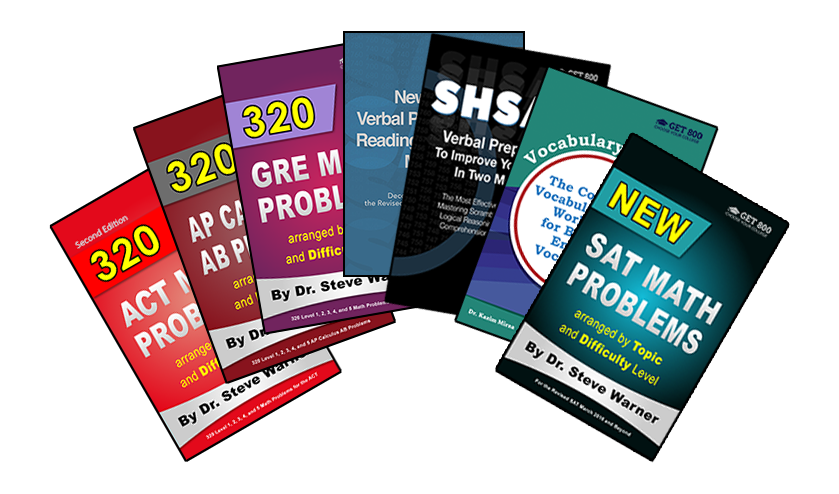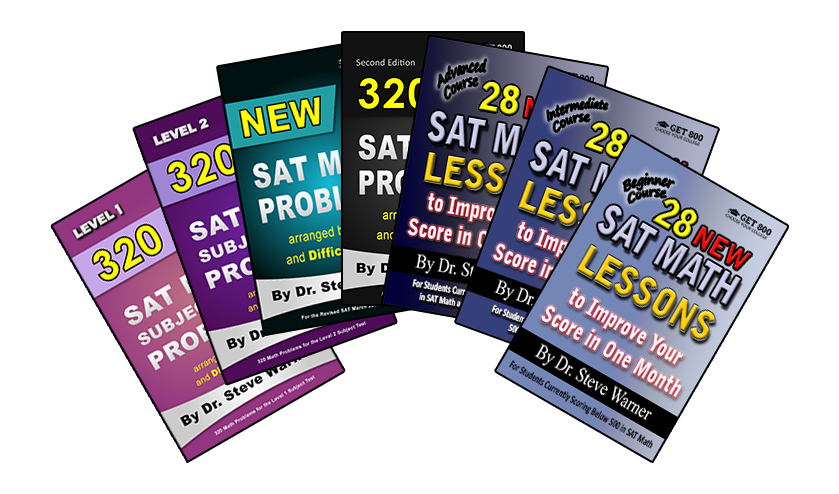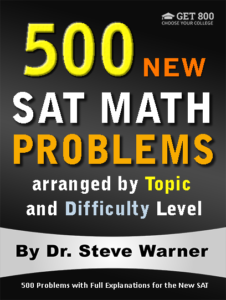
500 New SAT Math Problems
Just 19.99 on Amazon
Hi everyone! The latest edition of 500 New SAT Math Problems is now available in paperback from Amazon. This edition just has been modified from the previous edition to account for the changes on the Digital SAT.
The paperback is now on sale on Amazon for only $19.99. Note that once the sale ends (by the end of today), the price of this book will go up to $42.99.
The promotion has ended. Thanks to everyone who participated. The book is now available at its regular price here: 500 New SAT Math Problems
If you have any questions, feel free to contact me at steve@SATPrepGet800.com
Thank you all for your continued support!
A Trick For Free Two Day Shipping
I would like to finish this post with a little trick you can use to get free 2 day shipping on any of the books you decide to purchase without making any additional purchases. If you have never used Amazon Prime you can sign up for a free month using the following link.
Sign Up For Amazon Prime For Free
If you have already had a free trial of Amazon Prime you can simply open up a new Amazon account to get a new free trial. It just takes a few minutes! You will need to use a different email address than the one you usually use.
This next part is very important! After you finish your transaction, go to your Account, select “Manage my prime membership,” and turn off the recurring billing. This way in a month’s time Amazon will not start charging you for the service.
After shutting off the recurring billing you will still continue to receive the benefit of free 2 day shipping for one month. This means that as long as you use this new Amazon account for your purchases you can do all of your shopping on Amazon for the next month without having to worry about placing minimum orders to get free shipping.
Just be aware that certain products from outside sellers do not always qualify for free shipping, so please always check over your bill carefully before you check out.
Well I hope you decide to take advantage of this very special offer, or at the very least I hope you will benefit from my Amazon “free 2 day shipping trick.” Here is the link one more time:
Sign Up For Amazon Prime For Free
If you think your friends might be interested in this special offer, please share it with them on Facebook:
Thank you all for your continued support!
 Taking A Guess
Taking A Guess

This week I would like to discuss another very basic math strategy for standardized tests such as the ACT and SAT. This strategy is extremely simple to apply and it will often allow you to avoid messy algebraic computations. I call this strategy “Take a Guess.”
Sometimes the answer choices themselves cannot be substituted in for the unknown or unknowns in the problem. But that doesn’t mean you can’t guess your own numbers. Try to make as reasonable a guess as possible, but don’t over think it. Keep trying until you zero in on the correct value.
Example
Let’s see this simple technique in action with an appropriate math problem.
 Bill has cows, pigs and chickens on his farm. The number of chickens he has is three times the number of pigs, and the number of pigs he has is 2 more than the number of cows. Which of the following could be the total number of these animals?
Bill has cows, pigs and chickens on his farm. The number of chickens he has is three times the number of pigs, and the number of pigs he has is 2 more than the number of cows. Which of the following could be the total number of these animals?
(A) 14
(B) 15
(C) 16
(D) 17
(E) 18
Let’s take a guess and say that Bill has 3 cows. He then has 3 + 2 = 5 pigs, and also 3·5 = 15 chickens. So the total number of animals is 3 + 5 + 15 = 23. This is too big. So let’s guess lower and say that Bill has 1 cow. Then he has 1 + 2 = 3 pigs, and 3·3 = 9 chickens. It follows that the total number of animals is 1 + 3 + 9 = 13, too small. So Bill must have 2 cows, 2 + 2 = 4 pigs, and 3·4 = 12 chickens. Thus, the total we get is 2 + 4 + 12 = 18 animals. So the answer is choice (E).
Note: We were pretty unlucky to have to take 3 guesses before getting the answer, but even so, not too much time was used.
Let’s see what happens when we try to solve this algebraically:
If we let x represent the number of cows, then the number of pigs is x + 2, and the number of chickens is 3(x + 2). Thus, the total number of animals is
x + (x + 2) + 3(x + 2) = x + x + 2 + 3x + 6 = 5x + 8.
So some possible totals are 13, 18, 23, … which we get by substituting in the numbers 1, 2, 3, … for x. Substituting 2 in for x gives 18 which is answer choice (E).
Be warned that many students incorrectly interpret “three times the number of pigs” as 3x + 2. This is incorrect. The number of pigs is x + 2, and so “three times the number of pigs” is 3(x + 2) = 3x + 6. If this confuses you, you can simply avoid this algebra by using the strategy of taking a guess!
You can see that taking a guess is a quick and efficient way to solve this particular SAT math problem. If you begin solving this problem algebraically, then you are much more likely to make a computational error, and ultimately you need to take a guess anyway.
Want More Practice?
More information on this particular strategy, as well as many more problems to practice with, can be found in the Get 800 collection of test prep books. Click on the picture below for more information about these books.
For a more difficult SAT math problem where this strategy is useful, take a look at this post: Taking A Guess – A Further Example Of How To Use This Technique

Plugging In Answer Choices
In many math problems on standardized tests such as the ACT, SAT, and GRE, you can get the answer simply by trying each of the answer choices until you find the one that works. Unless you have some intuition as to what the correct answer might be, then you should always start with choice C as your first guess (on the new SAT you can start with choice B or C because there are four choices instead of five). The reason for this is simple. Answers are usually given in increasing or decreasing order. So very often if choice C fails you can eliminate two of the other choices as well.
There are a few exceptions to this rule. If the word least appears in the problem, then start with the smallest number as your first guess. Similarly, if the word greatest appears in the problem, then start with the largest number as your first guess.
Examples
Let’s take a look at two math problems – one where we start with choice C and one where we do not.
Level 4 Geometry Question
When each side of a given square is lengthened by 3 inches, the area is increased by 45 square inches. What is the length, in inches, of a side of the original square?
A) 3
B) 4
C) 5
D) 6
E) 7
Let’s start with choice (C). If the original length of a side of the square is 5, then the length becomes 8 when we increase it by 3. The original square has an area of 52= 25 and the new square has area 82 = 64. So the area is increased by 64 – 25 = 39 square inches. Thus, we can eliminate choice (C), and most likely (A) and (B) as well.
We next try choice (D). We have 62 = 36, 92 = 81 and 81 – 36 = 45. Thus, the answer is choice (D).
Here is an algebraic solution for those of you that really want to see it.
Let x be the length, in inches, of a side of the original square. The length of a side of the new square is x + 3. The area of the original square is x2, and the area of the new square is:
(x2 + 6x + 9) – x2 = 45
6x + 9 = 45
6x = 36
x = 6
Thus, the answer is choice (D).
For this particular question, I prefer the solution by starting with choice C to the more tedious and confusing algebraic solution.
Level 3 Number Theory Question
What is the largest positive integer value of k for which 3k divides 184?
A) 2
B) 4
C) 6
D) 7
E) 8
Note: This type of question is no longer tested on the SAT, but it could show up on the ACT or GRE.
Pull out your calculator. Since the question has the word “largest” in it, we will start with the largest answer choice which is choice (E), and we will divide 184 by 38. We type 18^4 / 3^8 into our calculator and the output is 16. Since 16 is an integer, the answer is choice (E).
Note that all five answer choices give an integer, but 8 is the largest positive integer that works.
Here is a direct solution for those of you who really want to see it.
The prime factorization of 18 is 18 = 2·32. Therefore:
184 = (2·32)4 = 24(32)4 = 2438.
From this prime factorization it should be clear that 38 divides 184, but 39 does not.
Again, for this particular question, most students will prefer the easier solution of starting with choice E (the largest answer choice) to the more confusing algebraic solution.
More Math Practice Problems
More information on this extremely useful strategy, as well as many more problems to practice with, can be found in the Get 800 collection of test prep books. Click on the picture below for more information about these books.
Plugging In – Part 1
Plugging In – Part 2
Speak to you soon!
 Free Proctored Exam
Free Proctored Exam

Sullivan Tutorials, in cooperation with Get 800, are inviting you to Staten Island, NY to take a free proctored PSAT. The test will be available on
May 12th from 6:30 – 9:30 P.M OR May 15th from 1:00 P.M. – 4:00 P.M.
We will be testing students to see if they can make it into one our National Merit prep groups. There is no charge to take this proctored test and there is no obligation to sign up for a course. To save yourself a seat, please send an email to:
You will receive the testing location via email.
About Sullivan Tutorials
For the past 25 years, Sullivan Tutorials has been responsible for about 60% of all the National Merit Semi-Finalists and all but a few of the Finalists on Staten Island. Students are placed in groups of 5-6 students with similar math scores. Groups meet for math sessions in the home of one student and for verbal sessions in the home of another student in the group.
National Merit Students
Students that make it into one of the National Merit groups will start meeting on weekday evenings in mid-July. They will meet for two 3 hour verbal sessions and two 2 hour math sessions in July and August and then 2 hour sessions once a week right up to the PSAT in October. They will then take the PSAT in October, and the SAT in Nov, Dec and Jan.
This is a very difficult year as the SAT has changed radically. To see some of the major changes, take a look at this article I wrote a while back: Preview the Math Changes on the “New” SAT
In addition, here are some of the changes in SAT Verbal:
- The essay will be optional – individual institutions will decide if they require the essay.
- There will be a 65 minute reading section.
- There will be a 35 minute language and writing section.
- There will no longer be sentence completions.
- There will be a greater emphasis on the meaning of words in extended contexts, and on how word choice shapes meaning, tone and impact.
Other Students
Students who do not make into one of the National Merit groups may start preparing with Sullivan Tutorials in mid-August to take the November, December and January exams if they are fairly strong in math and have scores that are reasonably high. All other students will begin preparing in January and take the new May exam.
Meetings in May will start with a 15 minute Q & A for parents and then students will take a 2 hour and ten minute PSAT. These exams will be graded before the students leave. Parents can either have a consultation right then, or they can do so by phone during the week after the exam.
National Merit Information
There are three levels for the National Merit. The first is 201 pts and up which is Commended Student. This information goes to any two colleges that the student designates. The second and more important level is Semi-Finalist. The cut off for this varies between 215 and 219 in New York State. 218 is the most common number. Students who get this are considered elite – most colleges want these students for bragging rights. These students are informed in early September of their senior year that they are semi-finalists and they are given the opportunity to write an essay that is evaluated by a committee. The top 1000 students in America are then designated as Finalists. Scholarship money is attached to this designation. On the aegis of becoming a finalist, many students are eligible for full scholarships to some of their chosen schools.
Once again, to save yourself a seat for the proctored exam, please send an email to:
 Improve Your Math Score by Teaching Math to Others
Improve Your Math Score by Teaching Math to Others

This week I would like to share an approach to improving your own math score on standardized tests such as the SAT and ACT by helping other students to improve their score. Every student I tutor is encouraged to pass along their knowledge to other students as there are many benefits for both students.
I believe that if you want to take yourself to the next level without too much effort, simply teach what you already know to someone else. Helping someone else to learn something new requires a much deeper understanding of the underlying material than simply having superficial knowledge of the subject matter. By engaging with someone else with less understanding than you, you will find that you often have to be creative with your explanations in order to get the other person to acquire a complete understanding of what you are trying to teach. This will force you to think about the subject matter in different ways. A nice side effect of this process is an overall improvement in both your current knowledge and your critical reasoning skills.
This is especially useful for ACT and SAT preparation and also mathematics in general where it often helps to solve problems by thinking “outside the box.” By helping others to understand how to solve problems you will be forced to review the tips, tricks and techniques that you already know. This will help you to internalize them more quickly so that you will be able to more easily identify problems where a specific strategy will be useful, and you will become more adept at using them.
Ways To Help Others
There are several ways to help others:
- You can find students in your school (or elsewhere) whose current score levels are below yours and offer to tutor them in a formal setting.
- You can let other students know that whenever they are stuck on a math problem, they should see you, and you will be happy to do your best to provide a solution for them.
- You can answer questions on forums where students post ACT, SAT, and general math questions.
Benefits Of Helping Others
And now here are some of the benefits of helping others to improve in math:
- You will be forced to review material that you have already learned.
- You will be more likely to internalize strategies that you are familiar with so that they’re application becomes faster and more reliable.
- You will begin developing a deeper understanding of the underlying mathematics leading to a higher level of mathematical maturity.
- You will improve your problem solving and critical reasoning skills at a faster rate than by simply learning new material.
- You will be providing a service to others by helping them improve their grades and standardized test scores.
So get out there and offer your tutoring services to someone who needs your help. You will be providing an invaluable service to another person. They will certainly be grateful for your help.
Of course, this applies not only to improving your math scores but to anything in life that you want to perform well in: be it college, sports, or even just playing video games!
And what about the fact that primarily you’re actually helping yourself to get into your college of choice? Well, we’ll keep that as our little secret.
And for daily SAT/ACT/GRE preparation, take a look at the Get 800 collection of test prep books.
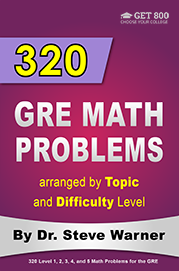 320 GRE Math Problems
320 GRE Math Problems

320 GRE Math Problems arranged by Topic and Difficulty Level is now available on Amazon. Click the following link to get to the book’s Amazon page: 320 GRE Math Problems
As an additional incentive to purchase this book today, I will also give you another book for FREE as a downloadable PDF file. You can choose ANY of my other books. So if you would like a different book, go ahead and purchase this one, forward me your Amazon confirmation email and let me know which of my books you would like for free. You will be provided with a link to download your additional free book. This offer is available until the end of the month (April 30, 2016).
Take a look at my product page to see all of my books: Get 800 Product Page
A Trick For Free Two Day Shipping
I would like to finish this post with a little trick you can use to get free 2 day shipping on any of the books you decide to purchase without making any additional purchases. If you have never used Amazon Prime you can sign up for a free month using the following link.
Sign Up For Amazon Prime For Free
If you have already had a free trial of Amazon Prime you can simply open up a new Amazon account to get a new free trial. It just takes a few minutes! You will need to use a different email address than the one you usually use.
This next part is very important! After you finish your transaction, go to your Account, select “Manage my prime membership,” and turn off the recurring billing. This way in a month’s time Amazon will not start charging you for the service.
After shutting off the recurring billing you will still continue to receive the benefit of free 2 day shipping for one month. This means that as long as you use this new Amazon account for your purchases you can do all of your shopping on Amazon for the next month without having to worry about placing minimum orders to get free shipping.
Just be aware that certain products from outside sellers do not always qualify for free shipping, so please always check over your bill carefully before you check out.
Well I hope you decide to take advantage of this very special offer, or at the very least I hope you will benefit from my Amazon “free 2 day shipping trick.” Here is the link one more time:
Sign Up For Amazon Prime For Free
If you think your friends might be interested in this special offer, please share it with them on Facebook:
Thank you all for your continued support!
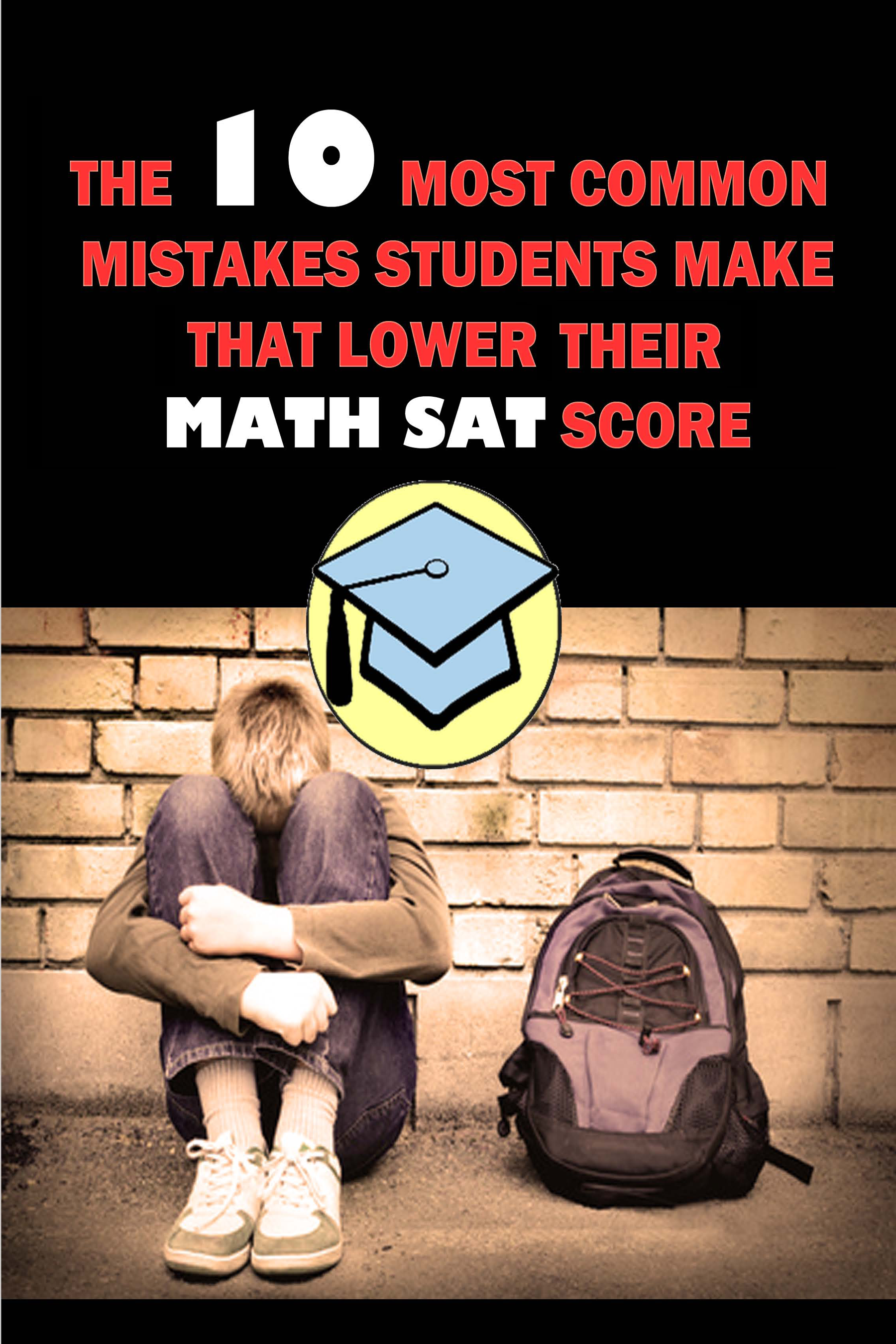
1. Attempting too many questions.
Students have been trained since they were very young that they need to answer every question that is on a test. For most in-class exams this is good advice. On standardized tests however this advice can be very bad. Attempting to answer too many questions on the SAT is guaranteed to lower your score. Here are some of the negative effects of trying to answer too many questions:
- Precious time is wasted attempting problems that are too hard.
- Students spend less time on easier problems, thus making careless errors.
- Test taking anxiety is much higher because the student has too many questions to get to in very little time. This leads to more careless errors.
In many cases simply by reducing the number of questions that you answer on the exam your score can go up 40 points or more. This may seem unlikely but if you think about it for a moment it makes perfect sense. If you eliminate just two careless errors per math section (1 multiple choice question and 1 grid in per section), you add 4 points to your raw score. This translates roughly to 40 points on the SAT.
So how many questions should you be answering? There is no absolute answer to this, but here is a general guideline. There are two math sections on the SAT – one where a calculator is allowed and one where a calculator is not allowed. The calculator section has 30 multiple choice (mc) questions and 8 free response (grid in) questions. The non-calculator section has 15 multiple choice (mc) questions and 5 free response (grid in) questions.
You should first make sure that you know what you got on your last SAT practice test, actual SAT, or actual PSAT (whichever you took last). What follows is a general goal you should go for when taking the exam.
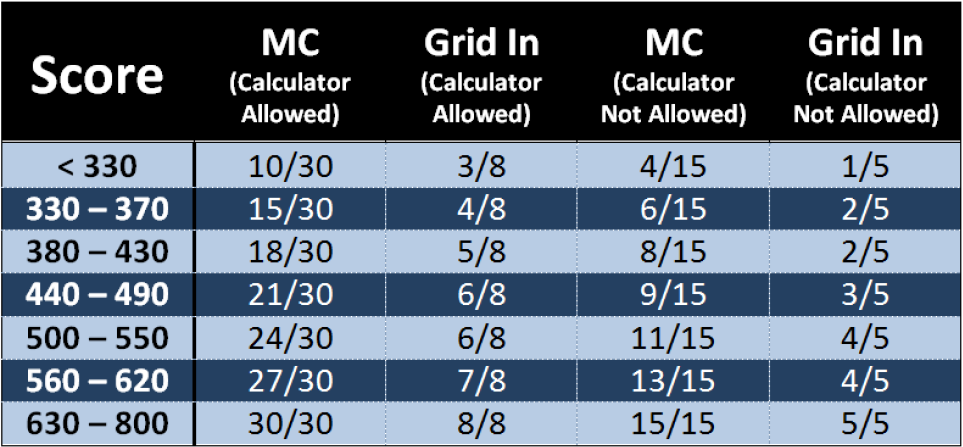
This is just a general guideline. Of course it can be fine tuned. As a simple example, if you are particularly strong at heart of algebra problems, but very weak at geometry problems, then you may want to try every heart of algebra problem no matter where it appears, and you may want to reduce the number of geometry problems you attempt.
One important thing. There is no guessing penalty on the current version of the SAT. So although you may not be attempting to solve some of the problems, you should still fill in an answer for every single question. Before time is up make sure to bubble in random guesses for the problems you did not attempt.
2. Not checking answers.
Many students feel a terrible amount of time pressure when taking their SAT. One of the primary causes of this is attempting too many questions, as stated above. Students therefore tend to rush through questions without checking over their work. This results in a significant number of careless errors.
The fact is that if you’re taking the test correctly, there is no need to rush through anything. You should be able to do each problem, and check it over quickly before moving on. Use the strategies that I teach you to get through problems quickly, but don’t rush through the actual mechanics of doing the problem.
Furthermore, you should always use at least five minutes at the end of the test for going back and checking over your earlier work. Remember, if you catch just two careless errors per section, your score will go up approximately 40 points.
3. Getting hung up on one question.
Students often have the misconception that if they abandon a problem, all the time that they have put into it has been wasted. Nothing could be further from the truth. In fact, sometimes leaving a problem temporarily is the best thing you can do to solve that problem. I can’t tell you how many times I have abandoned a problem to do something else, and then all of a sudden many minutes later the answer came to me without me even consciously thinking about it.
Even if this doesn’t happen, coming back to a problem later with fresh eyes is often very helpful. Your mind will not forget all the work you have already done on that problem.
So when is it time to move on? After you’ve been working on a question for about 1 minute you should make a decision. If you understand the question and think that you can get the answer in another 30 seconds or so, continue to work on the problem. If you still don’t know how to do the problem or you’re using a strategy that is going to take a long time, mark it off and come back to it later if you have time.
Always feel free to take a guess, but you still want to leave open the possibility of coming back to it later. Remember that every problem is worth the same amount. Don’t sacrifice problems that you may be able to do by getting hung up on a problem that is too hard for you.
Make sure that you are wearing a watch on test day. This will help you with your pacing.
4. Going with the first instinct on hard questions.
A standard piece of test-taking advice is to always go with your first instinct. In general this is good advice, but on standardized tests this advice is terrible.
The problem is that the more difficult SAT questions are specifically designed to trick you. This means that if you go with your first instinct, you are probably falling right into the trap that was laid out for you. On high numbered math questions on the SAT you should actually eliminate a choice if your intuition leads you to that answer too quickly. If you have a proper justification for why that particular answer is correct, then of course you can choose that answer. Otherwise however you should take a guess from the other choices.
5. Performing complicated computations.
It is never necessary to do messy algebra or perform tedious and complicated computations. If you find yourself doing this often, it means that you do not know some basic SAT test-taking strategies.
6. Taking the test without knowing the directions and given geometric formulas by heart.
Although I advise you not to rush through questions, you shouldn’t be wasting your time either. The last thing that you want to be doing during the test is reading the directions. They are always the same. Learn them ahead of time.
A more common mistake than that is walking into the test without knowing the geometric formulas that are given to you on the front of each math section. There aren’t that many. Just memorize them. It is a waste of time to be flipping back and forth.
The more advanced student may want to memorize additional formulas to save time while taking the test. Visit the following page for details: SAT Math Formulas
7. Overusing their calculator.
Sometimes I see students typing away on their calculators without taking any break. What they are usually doing here is wasting time. Your calculator is a tool that is there for you to speed up computations. It is not there to solve the problem for you. If you are taking the test right, you shouldn’t be using your calculator all that much.
That said, make sure that you do use your calculator for arithmetical computations (on the section where a calculator is allowed). This is usually quicker than doing computations by hand or in your head, and you’re less likely to make a careless error.
Finally, make sure that you know how to input things into your calculator correctly. Many students mess up their order of operations when using calculators, especially using parentheses correctly.
Remember that as a general rule numerators, denominators and exponents should all be in parentheses when using your calculator.
A complete list of things you should know how to do with your calculator can be found here: Graphing Calculator Features You Should Know for the SAT/ACT
8. Rounding or truncating decimals too soon on grid ins.
When gridding in an answer all four slots must be used unless the answer terminates before this. I see students get answers wrong all the time because they rounded an answer to soon. If your calculator displays 2.111111111 for the final answer, then your answer will be marked wrong if you grid in 2.1. You must grid in 2.11.
9. Being nervous for no reason.
Some students get test-taking anxiety, and some more than others. This is just a fact we have to deal with. There are many techniques you can use to alleviate test-taking anxiety such as meditation and other techniques of the mind.
There are some reasons for nervousness that can easily be avoided. For example, reducing the number of questions that you expect yourself to answer can go a long way in making you less nervous. When you come to a problem that is giving you a lot of trouble simply move on to the next one. You don’t need to answer all of them.
Another way to battle nervousness is through confidence. Spend at least 3 months before the exam preparing about 10 to 20 minutes each day. Learn all of the basic strategies that I teach, and make sure to practice some problems that are right at your ability level.
Although getting answers correct does not improve your score (only learning from your mistakes improves your score), getting some answers correct will instill confidence. This will ensure that you don’t decrease your score.
If you are a nervous test taker, then you may want to check out the following article I’ve written: Eliminating Test Taking Anxiety
10. Running out of steam.
The SAT is a long test. Many students lose too much endurance and start performing poorly towards the end of the exam. All you need to do to combat this is to be prepared for it. Try to do at least 2 full practice tests before the actual exam. Struggle through that length of time so you can feel it before it matters.
Get 800 Test Prep Books
If you like the information in this article, you may want to check out the Get 800 collection of test prep books.
Please share this information with your Facebook friends:
All the best…
Informal Algebra
Suppose we are asked to solve for x in the following equation:
x + 3 = 8
In other words, we are being asked for a number such that when we add 3 to that number we get 8. It is not too hard to see that 5 + 3 = 8, so that x = 5.
I call the technique above solving this equation informally. In other words, when we solve algebraic equations informally we are solving for the variable very quickly in our heads. I sometimes call this performing “mental math.”
Algebra The Formal Way
We can also solve for x formally by subtracting 3 from each side of the equation:
x + 3 = 8
-3 -3
x = 5
In other words, when we solve an algebraic equation formally we are writing out all the steps – just as we would do it on a test in school.
To save time on the SAT you should practice solving equations informally as much as possible. And although informal skills should take precedence during your SAT prep, you should also practice solving equations formally – this will increase your mathematical skill level.
Another Example
Let’s try another one:
5x = 30
Informally, 5 times 6 is 30, so we see that x = 6.
Formally, we can divide each side of the equation by 5:
5x = 30
5 5
x = 6
A Harder Example
Now let’s get a little harder:
5x + 3 = 48
We can still do this informally. First let’s figure out what number plus 3 is 48. Well, 45 plus 3 is 48. So 5x is 45. So x must be 9.
Here is the formal solution:
5x + 3 = 48
-3 -3
5x = 45
5 5
x = 9
Exercise
Try this one on your own: 3x + 4 = 31
And feel free to post your explanations in the comments.
College Board Question
In the following video I solve Question 1 from Test 1, Section 3 in the College Board’s Official Study Guide using the methods from this article.
Get 800 Test Prep Books
If you like the information in this article, you may want to check out the Get 800 collection of test prep books.
Please share this information with your Facebook friends:
I’ll see you next week…
Exponents Question with Solutions
Last week I posted the laws of exponents that can be useful to know for standardized tests such as the ACT and SAT. You can see that post here: Laws of Exponents
Here are the laws once again for your convenience.
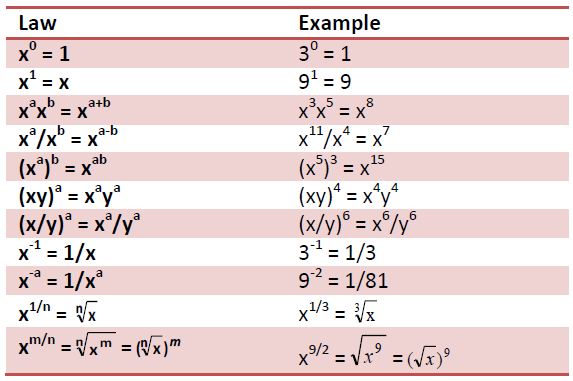
These should be memorized by students that are trying to get a perfect math score. I also mentioned that exponent problems can usually be solved by methods other than using the algebraic rules, but by using algebra you will solve them very, very quickly, giving you time to move on to other questions and to check your answers.
Last week, I had this level 5 exponents problem for you to solve:
Level 5 Exponents Question
If y = 7x, then which of the following expressions is equivalent to 49x − 7x+2 for all positive integer values of x?
A) y²
B) y² − y
C) y² − 7y
D) y² − 49y
Let’s look at two different ways to solve this problem.
Algebraic Solution
Let’s solve this algebraically using the exponent laws.
49x – 7x+2= (7²)x −7x72 = (7x)² − 49(7x) = y² – 49y
In the first equality we rewrote 49 as 7² and used the third law in our list to rewrite 7x+2 as 7x7². In the second equality we simply rewrote 7² as 49. Finally, in the third equality we replaced 7x by y twice.
This is choice D.
Solution by Picking Numbers
And here is an alternative solution using the strategy of “picking numbers”.
Let’s choose a value for x, say x = 2.
Then we have:
y = 7² = 49, and 49x − 7x+2 = 49² − 74 = 0.
Put a nice, big, dark circle around 0. Make it obvious that this is the value you are expecting to be your solution. Now substitute y = 49 into each answer choice:
A) y² = 49² = 2401
B) y² − y = 49² − 49 = 2401 – 49 = 2352
C) y² − 7y = 49² – 7*49 = 2401 – 343 = 2058
D) y² − 49y = 49² – 49*49 = 2401 – 2401 = 0
Since A, B, and C are incorrect, we can eliminate them. Therefore the answer choice is D.
As you can see the method of picking numbers is more time consuming than the algebraic method, but you will get the right answer as long as you are careful.
Whichever method you choose, you should try to check your answer with a different method if possible. If you can only solve the problem by picking numbers, then at least pick different numbers when you are “checking.”
And don’t forget to check out the Get 800 collection of test prep books.
If you liked this article, please share it with your Facebook friends:
Laws of Exponents
Students seem to have a lot of trouble remembering the basic rules of exponents. On standardized tests such as the ACT and SAT, you can often do problems involving exponents by using some basic strategies that avoid using these rules altogether. Using the exponent laws, however, usually leads to the quickest solutions. Students that are trying to get a perfect ACT or SAT math score will want to become more proficient in using these laws of exponents. Here is a basic review.

Now let’s try a level 5 question involving exponents.
Level 5 Exponents Question
If y = 7x, then which of the following expressions is equivalent to 49x − 7x+2 for all positive integer values of x?
A) y²
B) y² − y
C) y² − 7y
D) y² − 49y
You can see solutions to this problem here: Level 5 Exponents Question with Solutions
And don’t forget to check out the Get 800 collection of test prep books.
If you liked this article, please share it with your Facebook friends:
 Solving Quadratic Equations
Solving Quadratic Equations

by Completing the Square
Before we learn how to solve quadratic equations by completing the square, let’s go over how to solve the problem given to you two weeks ago.
Solution to Problem from Two Weeks Ago
Two weeks ago we went over how to solve simple quadratic equations using the square root property. To review that material click the following link: The Square Root Property on the SAT
I also promised to provide a solution to the following question:
(x – 3)2 = 2
What is the solution set of the above equation?
(A) {1, 5}
(B) {3 + √2}
(C) {3 – √2, 3 + √2}
(D) The equation has no solutions.
Solution: When we apply the square root property we get
x – 3 = ±√2.
We then add 3 to each side of this last equation to get the two solutions
x = 3±√2.
This is choice (C).
Completing the Square
Before we solve a quadratic equation by completing the square you may want to review the procedure of completing the square itself. You can find a detailed explanation of that procedure here: Completing the Square on the SAT
Solving Quadratic Equations by Completing the Square
A quadratic equation has the form ax2 + bx + c = 0.
Let’s use an example to show how to solve such an equation by completing the square.
Example: In the quadratic equation x2 – 2x – 15 = 0, find the positive solution for x.
Solution by completing the square: We first add 15 to each side of the given equation to get
x2 – 2x = 15.
We now take half of –2, which is –1, and square this number to get 1. We then add 1 to each side of the equation to get
x2 – 2x + 1 = 16.
This is equivalent to
(x – 1)2 = 16.
We now apply the square root property to get
x – 1 = ±4.
So x = 1 ± 4. This yields the two solutions 1 + 4 = 5, and 1 – 4 = –3. Since we want the positive solution for x, the answer is 5.
If you liked this article, please share it with your Facebook friends:

